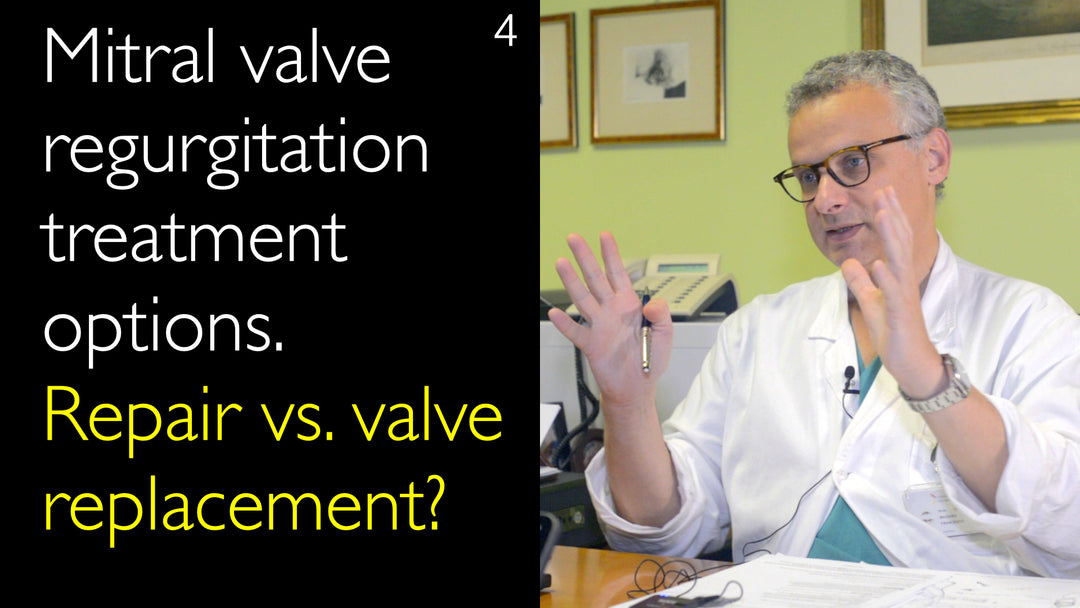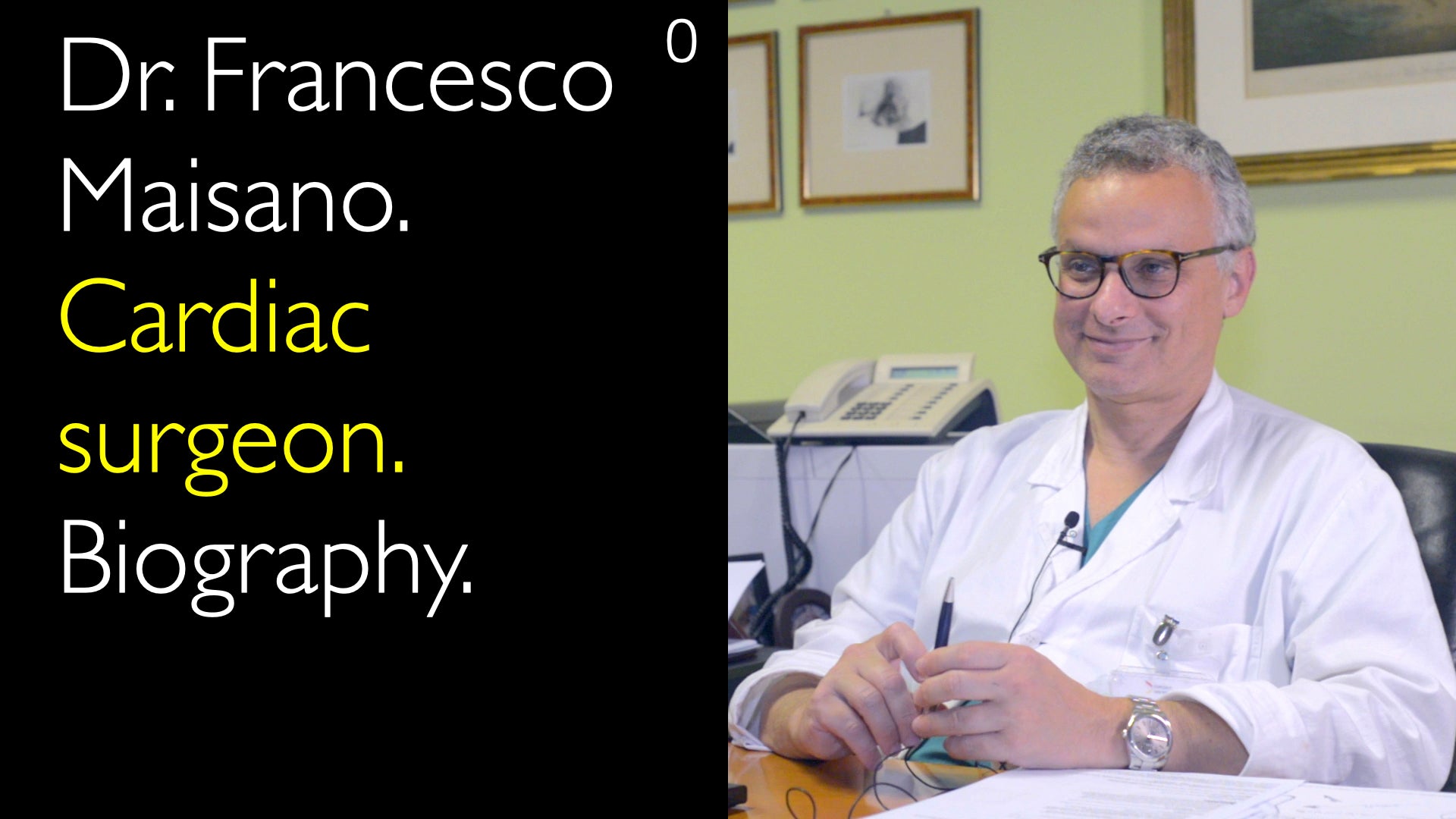ד"ר פרנצ'סקו מייזאנו, MD, סוקר את מטרות הטיפול בהעלמת הרגורגיטציה וההיצרות ללא פגמים שיוריים, ומצפה למעבר משמעותי לכיוון אפשרויות פולשניות פחות עבור כל קטגוריות הסיכון של החולים בשנים הקרובות.
טיפול בדליפת המסתם המיטרלי: תיקון כירורגי לעומת אפשרויות צינתור
קפיצה לפרק
- דליפה מיטרלית ראשונית לעומת תפקודית
- טיפול כירורגי בדליפה מיטרלית ניוונית
- תיקון בשיטת קצה-לקצה בצינתור
- הנחיות טיפול בדליפה מיטרלית תפקודית
- טיפולים עתידיים במסתם הטריקוספידלי
- דיון: תיקון לעומת החלפת מסתם
- תמליל מלא
דליפה מיטרלית ראשונית לעומת תפקודית
טיפול בדליפת המסתם המיטרלי דורש הבנה של שתי קטגוריות מחלה נפרדות עם אסטרטגיות שונות לחלוטין. ד"ר פרנצ'סקו מייסנו, MD, מדגיש שדליפה מיטרלית ראשונית נגרמת בעיקר מצניחה גנטית של המסתם המיטרלי. זה כולל ספקטום החל מחסר פיברו-אלסטי עם קרע של מיתר בודד ועד לרקמה עודפת ומשונה במחלת בארלו.
דליפה מיטרלית תפקודית, לעומת זאת, מתרחשת משנית למצבי לב אחרים כמו אי-ספיקת לב שבהם מנגנון המסתם תקין מבחינה מבנית אך מתפקד באופן לקוי. ד"ר אנטון טיטוב, MD, וד"ר מייסנו דנים כיצד הבדל אטיולוגי יסודי זה מכתיב מסלולי טיפול ותהליכי קבלת החלטות נפרדים לחלוטין לקרדיולוגים ולכירורגים.
טיפול כירורגי בדליפה מיטרלית ניוונית
ניתוח לב פתוח נותר תקן הזהב לטיפול בדליפה מיטרלית ניוונית בחולים צעירים ללא תחלואה נלווית. ד"ר פרנצ'סקו מייסנו, MD, מסביר שמחלת בארלו פוגעת בדרך כלל בחולים בני 40-55 ודורשת תמרונים כירורגיים מרובים מעבר לאנולופלסטיקה בלבד. תיקונים מורכבים אלה יכולים כעת להתבצע בגישות וידאוסקופיות פולשניות minimally invasive עם חתכים periareolar.
ניתוח רובוטי של המסתם המיטרלי מציע יתרונות בעיקר בחינוך כירורגי ולא בתוצאות החולים, לפי ד"ר מייסנו. הטכנולוגיה מאפשרת למתמחים לעקוב אחר פרוצדורות מורכבות יותר אך מספקת יתרונות מוגבלים לעומת טכניקות פולשניות minimally invasive קונבנציונליות עבור כירורגים מנוסים המשתמשים במכשירים ארוכים. מומחיות כירורגית זו מבטיחה שהחולים משיגים את יעדי הטיפול של היעדר דליפה, היעדר היצרות והיעדר נגעים אנטומיים שיוריים.
תיקון בשיטת קצה-לקצה בצינתור
תיקון מסתם מיטרלי בשיטת קצה-לקצה בצינתור חולל מהפכה בטיפול בחולים מבוגרים עם דליפה מיטרלית ניוונית ותחלואה נלווית. ד"ר פרנצ'סקו מייסנו, MD, מתאר טכנולוגיות כמו MitraClip ו-Pascal המאפשרות תיקון בצנתור ללא ניתוח פתוח. בעוד שזו לא הטכניקה הפשוטה ביותר, פרוצדורות אלה יכולות לספק תוצאות מצוינות בידיים מנוסות עבור חולים שאינם מועמדים אידיאליים לניתוח.
ד"ר אנטון טיטוב, MD, חוקר עם ד"ר מייסנו כיצד חלופות אנדו-וסקולריות אלה מרחיבות את אפשרויות הטיפול. ניסויים קליניים נוכחיים בוחנים גישות צינתור גם בחולים בסיכון נמוך, מה שמרמז על עתיד שבו יותר מקרים של דליפה מיטרלית ניוונית עשויים להיות מטופלים ללא ניתוח מסורתי. התחום ממשיך להתפתח עם מכשירים חדשים המופיעים משווקים גלובליים שונים.
הנחיות טיפול בדליפה מיטרלית תפקודית
טיפול בדליפה מיטרלית תפקודית עבר בעיקר לתחום האנדו-וסקולרי לפי ההנחיות הנוכחיות. ד"ר פרנצ'סקו מייסנו, MD, מציין שהתערבות כירורגית שמורה כעת בדרך כלל למקרים עם פתולוגיות משולבות הדורשות ניתוח מעקפים או פרוצדורות מסתם אבי העורקים. ההנחיות העדכניות לטיפול מאשרות גישות מדורגות באמצעות פרוצדורות אנדו-וסקולריות לדליפה מיטרלית תפקודית מבודדת.
ד"ר מייסנו מציין שמקרים של דליפה מיטרלית תפקודית מבודדת הפכו נדירים יותר ויותר בפרקטיקה הקלינית. רוב החולים מציגים מצבים נוספים כמו פרפור פרוזדורים או מחלת עורקים כליליים המשפיעים על החלטות הטיפול. התפתחות זו משקפת מגמות רחבות יותר לכיוון אסטרטגיות טיפול פולשניות minimally invasive שנותנות עדיפות לגורמים ספציפיים לחולה ולבטיחות הפרוצדורלית.
טיפולים עתידיים במסתם הטריקוספידלי
טיפול בדליפת המסתם הטריקוספידלי מייצג חזית מתפתחת בניהול מחלות מבניות של הלב. ד"ר פרנצ'סקו מייסנו, MD, חוזה שתוך שלוש עד ארבע שנים, רוב הפרוצדורות הטריקוספידליות יעברו לגישות צינתור. מועמדים כירורגיים נוכחיים עם תפקוד חדר ימני שמור ותחלואה נלווית מינימלית יקבלו בסופו של דבר פתרונות אנדו-וסקולריים מלאים כולל אנולופלסטיקה בצינתור, תיקון קצה-לקצה והחלפת מסתם.
ההתפתחות משקפת דפוסים היסטוריים בטיפול במסתם המיטרלי שבהם החלפה האפילה בתחילה על טכניקות תיקון. ד"ר אנטון טיטוב, MD, וד"ר מייסנו דנים כיצד פתרונות לתיקון המסתם הטריקוספידלי מתמודדים כעת עם אתגרים טכניים שעשויים להפוך טכנולוגיות החלפה לאטרקטיביות יותר למרות חסרונות פוטנציאליים. חדשנות מתמשכת זו משקפת את ההתקדמות המתמדת של התחום לכיוון שיטות טיפול פולשניות פחות.
דיון: תיקון לעומת החלפת מסתם
הדיון על תיקון לעומת החלפת המסתם המיטרלי מתמקד בניבוי לעומת תוצאות ארוכות טווח. ד"ר פרנצ'סקו מייסנו, MD, מסביר שהחלפת מסתם מציעה ניבוי בלתי תלוי במפעיל מכיוון שכישלון משקף בדרך כלל מגבלות מכשיר ולא טכניקה. תכונה אטרקטיבית זו עשויה להניע עלייה בשיעורי ההחלפה בחמש השנים הבאות למרות העדיפות המוכחת של תיקון לדליפה מיטרלית ניוונית.
ד"ר מייסנו תומך אישית בתיקון כל מסתם אפשרי, תוך הכרה במאמץ הנוסף הנדרש אך הדגשת פרופיל הבטיחות העדיף והיתרונות לחולה. התקדים ההיסטורי מימיה הראשונים של הכירורגיה הקרדיאלית מראה כיצד טכנולוגיות החלפה הדיחו בתחילה טכניקות תיקון לפני שהוכחות אישרו מחדש את יתרונות התיקון. דפוס מחזורי זה מיידע תחזיות נוכחיות לגבי האופן שבו טכנולוגיות החלפה מתפתחות בצינתור עשויות להשפיע על דפוסי פרקטיקה עתידיים.
תמליל מלא
ד"ר אנטון טיטוב, MD: דליפת המסתם המיטרלי היא מחלה שכיחה של מסתמי הלב. היא נפוצה במיוחד בחולים קשישים. אתה כירורג לב מוביל בטיפול פולשני minimally invasive בצניחת המסתם המיטרלי. אז היום, אילו אפשרויות טיפול קיימות לחולים עם דליפה מיטרלית תפקודית? כיצד לטפל בדליפה מיטרלית מבנית ראשונית? מה יהיה ההבדל בהתוויות הטיפול בין שני הגורמים לדליפה מיטרלית?
ד"ר פרנצ'סקו מייסנו, MD: זו שאלה טובה. זה רעיון טוב לחלק את שני התחומים האלה, שדומים מאוד כי כולם קשורים למסתם המיטרלי. אבל basically, הם מאוד שונים. וגם, אסטרטגיית הטיפול totally different.
אז בואו נתחיל עם הדליפה המיטרלית הראשונית כי זה probably easier. דליפה מיטרלית ראשונית נובעת mainly מ-so-called צניחה גנטית של המסתם המיטרלי. בקטגוריית צניחה זו, יש כמה תת-קטגוריות.
החלוקה הקלאסית היא דליפה מיטרלית ניוונית due to חסר פיברו-אלסטי, כלומר המסתם המיטרלי almost normal. יש נגע אחד, single lesion, שהוא usually קרע של מיתר. יש אזור flail. Usually, זה נגע flail P2. זה הנגע הנפוץ ביותר. הוא באמצע העלה האחורי של המסתם המיטרלי.
אבל המסתם המיטרלי עצמו still looks normal. יש עלים מסתמיים דקים, ואין הסתיידות של המסתם המיטרלי. אין רקמה עודפת במסתם המיטרלי. Then at the other end of the spectrum, יש את so-called מחלת המסתם המיטרלי של בארלו או מחלה myxomatous. שם המסתם המיטרלי totally and grossly altered.
יש שינוי עצום של כל המסתמים המיטרליים, עם רקמה עודפת. המסתם המיטרלי מעובה עם נגעים מרובים, צניחות מרובות. Then you have all the intermediate forms of mitral valve disease.
So even הדליפה המיטרלית הניוונית היא not one disease, but it's a continuum of disease. So מציאת הגורם לדליפה מיטרלית היא one of the issues לקבלת החלטות נכונות בתחום הטיפול בדליפה מיטרלית. הפרמטר האחר בהחלטות טיפול הוא המצב הקליני של החולה.
דליפה מיטרלית ניוונית היא usually מחלה שנמצאת בחולים relatively young. In particular, מחלת המסתם המיטרלי של בארלו נמצאת בחולים between 40 and 55 years of age. This is what you see in these patients with mitral regurgitation. You can see even much younger patients than that age.
In this young generation, I think ניתוח לב פתוח remains the best solution for most patients. It is so mainly because מחלת המסתם המיטרלי של בארלו היא מחלה very diffuse. And quite often, we need to do more than one surgical maneuver לטפל במסתם המיטרלי in addition to אנולופלסטיקה של המסתם המיטרלי.
This can be done today by a very minimally invasive approach. On most occasions today, for טיפול כירורגי במחלת בארלו, we use a videoscopic approach with a periareolar incision.
At the moment, we have not been active with a robotic mitral valve repair, but ניתוח רובוטי של המסתם המיטרלי הוא just a solution that is more intuitive for the surgeon. If you have enough experience with minimally invasive approaches and using long instruments, there is not much advantage of robotic mitral valve surgery.
The only advantage, a real advantage of robotic mitral valve surgery, is in education. Because you can teach other surgeons easily, you can see and really follow the surgeons doing robotic mitral valve procedures. And for some complex cardiac surgery procedures, it's nice to have advanced technology.
So if you have a patient with degenerative mitral regurgitation in a young patient, if there are no comorbidities, I think there is no discussion that ניתוח לב פתוח remains the gold standard of treatment, at least today. But there are many patients who are older and who have the genetic mitral valve disease.
They have one or two lesions or even more in their mitral valve. And today, we can treat these patients pretty easily with specifically תיקון מסתם מיטרלי בשיטת קצה-לקצה בצינתור. We have different tools for transcatheter mitral valve repair. There is MitraClip. There is Pascal. There are some other methods of transcatheter mitral valve repair coming from Asia.
Today, every patient, almost every patient, can be treated with these technologies in good hands. It is not the simplest technique to treat degenerative mitral regurgitation with a transcatheter edge-to-edge mitral valve repair. But after doing many cases of mitral valve regurgitation treatment, I can provide a good service to most of our patients.
There are also other things. But let's make it simple. So in principle, לדליפה מיטרלית ניוונית יש mainly a surgical solution. הטיפול בדליפה מיטרלית ניוונית becomes an endovascular alternative for those patients who have a less ideal condition for open surgery.
אלו הם המטופלים הקשישים, מטופלים עם תחלואות נלוות, וכן הלאה. וכל מטופל צריך לצאת מההליכים האלו ללא דליפה מיטרלית, ללא היצרות מיטרלית, וללא פגמים אנטומיים שיוריים. אלו צריכים להיות יעדי הטיפול בדליפה מיטרלית. זהו יעד שניתן להשיג בכל מטופל.
אם נצפה לעתיד, אני צופה שנראה יותר ויותר טיפולים תוך-כלייתיים גם במטופלים בסיכון נמוך עם דליפה מיטרלית. יש ניסוי קליני שמתנהל ברגע זה.
דליפה מיטרלית תפקודית נמצאת היום בעיקר בתחום הטיפול התוך-כלייתי. אלא אם למטופלים יש פתולוגיות משולבות, אפילו ההנחיות העדכניות ביותר מכריזות על כך. בשילוב עם אינדיקציות אחרות, למשל, ניתוח מעקפים כליליים (CABG) או היצרות אבי העורקים, דליפה מיטרלית תפקודית ניתנת לטיפול כירורגי.
אבל גם ההנחיות העדכניות ביותר לטיפול קובעות שניתן להשיג גישה מדורגת עם הליכים תוך-כלייתיים. כך שאנחנו גם מתקדמים בתחום הזה של טיפול תוך-כלייתי בדליפה מיטרלית תפקודית.
כשאנחנו נכנסים לדליפה מיטרלית תפקודית מבודדת או דליפה טריקוספידלית מבודדת, אני חושב שיש מעט מאוד אינדיקציות לניתוח פתוח. אולי ניתוח פתוח יכול להתבצע רק בדליפה של המסתם הטריקוספידלי במטופלים עם תפקוד חדר ימני שמור מאוד וללא תחלואות נלוות. היום דליפה של המסתם הטריקוספידלי נמצאת עדיין בשלב מוקדם.
אז מחר, אני אנתח, למשל, אישה בת 70. אחרת, היא במצב טוב. יש לה תפקוד חדר ימני טוב. אני בטוח שמחר נוכל לבטל את הדליפה הטריקוספידלית במטופלת הזו עם גישה כירורגית פולשנית מינימלית.
אבל מצד שני, אני יודע שבעוד שלוש עד ארבע שנים, המטופלת הזו כבר לא תעבור ניתוח לב פתוח כי אוכל לבצע אנדופלסטיה דרך צנתר באותה צורה שאני עושה זאת היום כירורגית. אוכל לבצע תיקון שסתום edge-to-edge דרך צנתר באותה צורה שאני עושה זאת היום כירורגית. אוכל להשתיל שסתום לב חדש בשיטה תוך-כלייתית באותה צורה שאני יכול לעשות זאת כירורגית.
אז ככל שהמומחיות משתפרת וגוברת בטיפולים במסתם הטריקוספידלי, נראה יותר ויותר הליכים תוך-כלייתיים גם בטיפולים במסתם הטריקוספידלי. דליפה מיטרלית תפקודית מבודדת נדירה כעת. אני לא זוכר אף מטופל שטיפלתי בו בשנים האחרונות שהייתה לו רק דליפה מיטרלית תפקודית.
אולי היה להם גם פרפור פרוזדורים; אולי הם היו צריכים ניתוח מעקפים כליליים. אבל דליפה מיטרלית תפקודית מבודדת הייתה אחד מנושאי הטיפול העיקריים שלנו במשך שנים רבות, אבל עכשיו היא נעלמה.
אז הגישה הפולשנית המינימלית היא בעיקר מה ששולט כיום בטיפול בדליפה מיטרלית.
כן, אני חושב שטיפול פולשני מינימלי בכירורגיה משמעותו תורקוטומיה מינימלית ומערכת וידאו תורקוטומיה מינימלית עם או בלי רובוט. או שזה אומר טיפול תוך-כלייתי מלא על לב פועם. אז אלו שני התחומים שבהם אתה יכול לראות פתרון עבור המטופלים האלו.
וברוב המקרים, אנחנו מדברים על תיקון שסתום הלב. עכשיו החלפת שסתום הלב צצה בשיטות טיפול תוך-כלייתיות. ספציפית, אני חושב שבמחלת המסתם הטריקוספידלי, פתרונות התיקון עדיין לא כל כך מושלמים.
והאם החלפת המסתם הטריקוספידלי תהפוך ליותר ויותר זמינה? האם זה ישנה את הפרספקטיבה שלנו על הטיפול במחלת המסתם הטריקוספידלי? אני לא יודע.
כבר עשיתי את התחזית שלי לפני כמה שנים. כבר נשאלתי את השאלה הזו לפני יותר מחמש שנים. ברגע שטכנולוגיות החלפת שסתום הלב הטריקוספידלי יהפכו לזמינות, האם תיקון שסתום הלב ייעלם? והתשובה שלי מלפני כמה שנים היא אותה תשובה היום.
אולי תיקון שסתום הלב ייעלם, אבל פרופיל הבטיחות של תיקון שסתום הלב גבוה יותר. אבל ברור, כנראה נראה מצב דומה לכירורגיה הלבבית בשנות ה-1950. אז לא הייתה החלפת מסתם מיטרלי זמינה. וכך, כל שסתומי הלב תוקנו.
ואז החלפת המסתם המיטרלי הפכה זמינה, וכל מנתחי הלב נטשו את תיקון שסתום הלב כי זה היה קוצ





